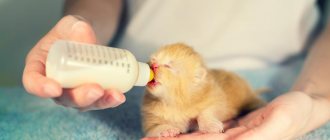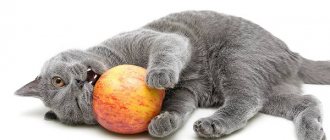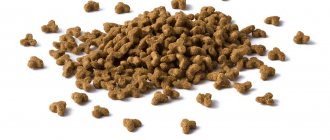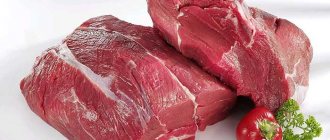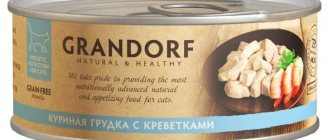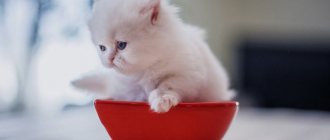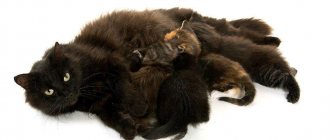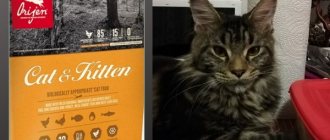Save the article:
Not everything in life always works out perfectly, and it happens that a small kitten is left without mother's milk. If you are raising a baby one month old and there is no mother cat nearby, then you need to find out what kind of care he needs and provide the necessary nutrition. feed a one-month-old kitten - at this age, the small creature does not have strong immunity and skills for independent living. If the issue of feeding a meowing lump has become relevant, then you will have to study all the available information and take into account many of the nuances of raising a new pet.
Weaning from a cat
It is not recommended to take a kitten away from its mother before one and a half months, because the baby’s immunity is too weak and its habits have not been formed. You need to do this smoothly and methodically - day after day, accustoming the pet to the absence of its mother nearby. In the new habitat, conditions must be created for the kitten to remain calm - a sleeping place, a tray for natural needs, a bowl for food, clean drinking water.
It is more difficult for individuals whose contact with the cat is interrupted suddenly, for various reasons. Adaptation to a new home will take longer, but don’t be alarmed: sooner or later your kitten will get used to the changes.
How to properly bathe a cat at home if it is afraid of water and why you shouldn’t do it often
The diet of a one-month-old baby is dominated by liquid or semi-liquid food, similar in consistency to mother's milk. Very young kittens are fed an adapted formula, which is a substitute for natural milk. The optimal composition of mixtures containing all vitamins and microelements is produced by Beaphar, Gimpet and Royal. Additionally, you will need a nipple, measuring cup and container. The powder is diluted according to the instructions on the package.
The use of ready-made formula for children is allowed in extreme cases - in the absence of specialized food for kittens. Infant formula of the category 0 - 6 months is diluted with water one and a half times more than the indicated dosage. As a last resort, cow's milk - boiled, cooled and mixed with egg yolk - will come in handy.
The kitten is fed food heated to a comfortable temperature using a syringe without a needle, pipette or pacifier. You can teach your baby to be independent now - by letting him lick his finger with milk or putting his face in a bowl. Gradually, having become interested in food, the pet will begin to eat on its own.
One month old babies
What to feed a one-month-old kitten (up to 1 month)
A well-fed kitten either sleeps peacefully or quietly sucks the cat. But if kittens crawl around their mother, refuse the nipple, squeak and grab an outstretched finger - these are signs that the child is hungry.
Where to start with complementary feeding or full feeding of a week-old pet?
Prepare a bottle with a nipple, a dropper or syringe without a needle, and a special mixture designed to replace cat milk for a week-old kitten.
Here are some simple recipes on how to feed small kittens at home:
- Raw egg yolk + half a liter of concentrated milk
- Dry yeast (2.5 g) + whole milk powder (15 g) + whole cow's milk (50 g)
- Hard-boiled egg + beaten egg white + vegetable oil (1 g) + grape sugar (4 g)
- Half an egg yolk + corn oil (teaspoon) + whole milk (50 ml)
These and other recipes will also be useful if the kitten grows up without a mother cat and (correctly), its feeding is entirely your responsibility.
Read about recipes for feeding kittens up to a month without a cat
What foods should you not feed your kitten?
- Dry or wet food. There is no unanimity on this issue; rely on your own prudence and intuition. Therefore, here we put a question mark – ?
- Cow's milk. It is better to replace it with goat milk - it is not so fatty for the baby’s digestion. If you can’t get goat milk, then for very small kittens you can buy special powdered milk in pet stores
- Fermented milk products with high fat content
- Fish. In principle, children should not be given fish at all, but theoretically, sea fish is not harmful. Freshwater is prohibited, especially raw water, as it provokes the formation of urolithiasis and can become a source of infection with worms
- Salt, spices
- Sausages
- Potatoes are not at all digestible by the stomach of a domestic cat, so they are not given in any form.
- Legumes. Soy, peas, beans are not digested by the intestines and as a result we get bloating and fermentation in the intestines
- Cheese - due to its fat content
- Pork
- Sweets
- Chocolate. This particular sweet contains theobromine, a poison that causes severe poisoning and death in cats.
- Flour
- Mixed diet is harmful for kittens
Read more about what not to feed.
Principles of proper feeding at home
At 5 weeks of age, a kitten's stomach is the size of a thimble, so it should be fed little by little often. The ideal option is 5 – 6 times throughout the day at intervals of 4 hours.
Night feedings are gradually being eliminated. The baby can eat no more than two teaspoons of food at one time, and the daily food intake should not exceed 120 ml.
It is easy to identify a full-fed kitten by its rounded tummy and milk bubbles near the mouth. In addition, a well-fed pet falls asleep immediately after feeding. Signs of malnutrition include poor sleep, trembling and lethargic behavior. Have you seen these symptoms? Adjust your diet immediately!
To enrich the diet, new products allowed at this age are gradually introduced:
- goat milk (diluted 1:1 with boiled water);
- liquid semolina or rice porridge (crushed);
- soup without added salt (with lean boiled meat) – once a week;
- low-fat cottage cheese puree with boiled yolk – 2 times a week;
- minced meat (except pork);
- fish fillet without bones and salt;
- fermented milk products without sugar.
Offer new food gradually - at intervals of 3 days. This way you can monitor your body’s reaction to changes in your diet. If vomiting, diarrhea or allergies occur, stop feeding. You shouldn’t hope that “it will get used to it over time.” This is deadly! Errors in nutrition at such a young age can result in death for the baby.
An attentive owner will always notice the pet’s reaction to an innovation. Having offered a new product on your finger, the kitten will either happily eat the treat or turn away indifferently. There is no need to insist, because food should be a joy!
Offer complementary foods at the very bottom of the bowl so that the baby does not accidentally fall into it, trying to taste the yummy food.
For your pet’s health, you need to completely remove smoked meats, fatty and fresh meat, salt, pork and sugar from the diet.
Clean water must be available at all times. It is better if these are several bowls located in different corners of the apartment.
Purina food
Industrial feed
Natural cat milk has unique characteristics. It is rich in proteins with relatively low fat content. Not every industrial mixture can serve as an analogue of such feeding. When choosing ready-made food, the owner should pay attention not to the bright packaging and advertising promises of the manufacturer, but to the optimal composition and the absence of harmful substances.
When you see the cost of ready-made formula for kittens, you can get confused. Remember, premium-level food cannot be cheap! A more economical option is unsafe for the baby. However, don't despair. The volume of mixture that a pet can eat is small, so one pack of food will last for a long time.
It’s not difficult to prepare food; just dilute the powder mixture with water, after which it becomes suitable for use. Before the age of 1 month, mother's milk substitutes are the main source of nutrition, and when the kitten reaches 4 weeks, a gradual introduction of complementary foods is necessary.
Many manufacturers offer ready-made food for babies, the most famous of which are Purina, Royal Canin, Nutri-Vet, Canina, and Beaphar.
Natural ingredients
The desire to accustom a kitten to natural feeding is understandable - this way you can always be sure of the quality of the product and its benefits for the body. The only thing you shouldn’t do is mix industrial and natural food. The fact is that from birth, the pet’s body produces the necessary enzymes for digestion, taking into account the food consumed. Mixed nutrition has a negative impact on the fragile digestive system and weakens the immune system.
Have you decided to stick to natural feeding? This is right! By teaching your baby to variety from childhood, you can raise an omnivorous cat, and not a capricious stubborn one. The main rule is to exclude food from the host’s table in your diet. Firstly, it is too salty and spicy, and secondly, it is absolutely not suitable for a cat’s diet.
The list of allowed foods for a one-month-old kitten is quite long:
- liquid porridge with milk or weak broth made from buckwheat, rice or millet;
- boiled fish, boned;
- quail eggs;
- boiled lean meat pate;
- dairy products.
The belief that fish is extremely beneficial for cats of all ages is wrong. It has been proven that frequent consumption of fish dishes leads to kidney inflammation. If you plan to castrate the cat in the future, then it is better to completely exclude fish from the menu.
Age-appropriate food for kittens
It is important to feed your furry pet according to its age: the menus of a 2-week-old and a 3-month-old baby are very different.
1) What to feed a small kitten for 1 month?
During the first month of life, the baby eats milk from its mother, which provides the body with the necessary nutrients. From the 5th week, the period begins to try new things in order to cover the growing naughty boy’s need for food. Getting used to “adult food” and lapping from a bowl is an important point. The following products will perfectly fulfill the above goals:
- kefir;
- fermented baked milk;
- milk suspensions.
The milk suspension is ideal for the owner who is deciding the question: how to feed a 1-month-old kitten left without a mother?
Kittens begin to chew food during this period; pate for kittens is suitable for developing the skill. We invite you to purchase the product at the Zoomix store.
If the owner has chosen natural food as the main method, then you can stop at liquid porridge, adding chopped, pureed meat to the dish.
2) What can you feed a 1.5 month old kitten?
The diet is becoming more varied, lean boiled meats are being added to the menu: chicken, beef; new fermented milk products (cottage cheese).
3) What to feed a 2-month-old kitten: homemade food or ready-made food?
The main advice: increase the amount of solid food. Add vegetables, mix with meat, first chop very finely (grinding until minced is not recommended). Cereals dilute the meat diet well, digest in plenty of water, offer in liquid form, this is the main requirement for the care and feeding of a 2-month-old kitten. Milk remains the main product (50% of the diet). It’s too early to switch to food.
4) How and what to properly feed a kitten for 3-4 months (veterinarian advice)?
The age has come when fermented milk products are reduced by one-fourth from the entire table, whole milk is removed completely (lactose ceases to be absorbed). We cut the products a little larger, and prepare the porridge less liquid. The time has come to add raw vegetables to the kitten's diet at 3 months: zucchini, cucumber, potatoes.
5) What to feed a 5-6 month old kitten?
From five months, solid food completely replaces liquid food. When preparing vegetable and cereal dishes, make the consistency thicker.
Have you decided to switch to dry food? Now is the best time. For the first feeding, soak the pellets in water. What food is best to feed a kitten? Choose quality food: Hills Kitten, Royal Canin, Pro Plan. The period is characterized by the addition of sea fish (previously deboned) to the diet.
We hope the article helped solve the main difficulties with nutrition and caring for a meowing pet. Do you have any questions about choosing quality food? We invite you to the Zoomix store: experienced consultants will help you find the best!
Milk and dairy products
Goat's milk
A kitten's skeletal system is constantly developing. Therefore, the calcium contained in milk is simply necessary.
Before use, milk is boiled, a little honey is added to enrich the composition, and cooled until warm. 8% cream is no less useful; you can pamper your baby with fermented baked milk, goat milk or sugar-free yogurt.
Each new product is introduced gradually, taking into account the body’s reaction.
Are substitutes needed?
Milk substitutes do not always benefit a growing body. Kittens with congenital diseases may not survive without maternal nutrition and colostrum. For such pets, the diet is recommended by a veterinarian.
Finding a suitable milk substitute is not easy; it must be as close in composition as possible to breast milk. In addition to basic nutrients, high-quality mixtures should contain:
- taurine;
- vitamin supplements and minerals;
- polyunsaturated acids;
- microelements.
Look on the packaging for instructions on what age group the mixture is intended for.
Convenient double bowl
Vitamins and nutrition
What else is missing for the full development of a pet? To raise a healthy, active cat with a good appetite and silky coat, you need vitamins and minerals.
When choosing a drug at a veterinary pharmacy, it is better to first consult with a doctor. He will tell you the name of the product and possible contraindications.
The components in medications may coincide, which leads to hypervitaminosis (excess vitamins in the body). It’s easy to avoid this by studying the composition on the packaging.
The most popular supplement for kittens 1 - 1.5 months old is fish oil. The liquid from the capsule can be mixed with food, feeding the pet 2 times a week.
Among natural products, kittens will be happy to try fresh herbs (in combination with cottage cheese), apples (ground to a puree), and cucumbers. The frequency of feeding is the same - no more than 2 times over 7 days. Bran is limited in the diet, at least until 4 months of age.
Are canned foods allowed?
A business person who is rarely at home has a catastrophic lack of time to buy natural products and, especially, to prepare food every day. The solution is to use canned kitten food. Before a month it should be pate or mousse, after a month it should be canned food in the form of pieces. In premium-level food, the composition is selected taking into account the baby’s requirements for vitamins and minerals, so pharmaceutical supplements may not be needed.
When offering canned food to your kitten, you need to be sure that he can drink water on his own. When switching to an industrial type of feeding, the need for fluid increases. Of course, water is a less tasty option than milk, and your pet may refuse to drink it. In this case, you can replace the water with your usual milk formula or sweeten it a little.
Anorexia in a cat
A disease that occurs not only in humans, but also in cats, such as anorexia, requires special attention. Only a small number of cat owners know how dangerous it is. Unlike emaciation, when an animal for one reason or another does not receive all the necessary nutrients, anorexia is a disease in which the animal ceases to feel the feeling of hunger.
In people, anorexia manifests itself as an aversion to any food, vomiting after trying to eat something, nervous conditions and mental disorders. This phenomenon is not observed in cats; they simply may refuse food at a certain point. What makes animals go against the survival instinct and begin to balance on the brink of life and starvation? There may be several reasons:
- disturbances in the functioning of the sense organs - after a traumatic brain injury or accident, cats sometimes lose their sense of smell or touch, which is why they cease to smell and taste food and, in principle, refuse to perceive it as something edible;
- chemotherapy - this procedure, vital in the treatment of malignant neoplasms, has a significant effect on all the internal organs of the animal, which is why the cat becomes lethargic, apathetic and refuses food;
- postoperative rehabilitation - the period when the cat is recovering from anesthesia can also be very difficult for the body (in particular, disturbances in the functioning of the vestibular apparatus, psychomotor disinhibition and loss of orientation in time and space may occur), in this state the cat barely gets to the tray, not not to mention a bowl of food, and postoperative effects may still appear for several weeks.
It is impossible to cure anorexia by fattening, so it is necessary to contact professional veterinarians. An experienced specialist will prescribe either tube feeding with special solutions, or prescribe drips for intravenous administration of nutrients.
Is it possible to use human baby food?
The mention of newborn kittens always brings a smile. These babies seem just like babies - why not save on cat food and buy regular infant formula? Is this allowed? Let's try to figure it out.
Your pet is an individual with its own characteristics of health, character, and level of activity. The nutritional needs of kittens and newborns differ significantly, although there are often cases when baby food becomes the saving grace in artificial feeding of a kitten.
Infant formula can be used in three cases:
- For feeding kittens – sucklings left without their mother ahead of time. In this case, the powder is adjusted with water to the desired consistency in a ratio of 1:1.5.
- If you have an allergic reaction to cat food or congenital diseases in your pet.
- As a dietary supplement.
Canned meat or vegetable purees should not contain salt, pepper, starch or onions. These components will not be digested in the kitten's body. A one-month-old baby can be offered Agusha baby puree - an inexpensive and high-quality option for feeding small children.
Convenient feeding option
Food
Along with a variety of food products for pets, ready-made formulas are produced for artificial feeding of newborn kittens, which can be used from the first days of the cubs’ life. This is the best food for an orphan in the first, most difficult month of his life.
For a growing pet, proper food is the key to its good health and harmonious development. There are two types of food: natural and ready-made. The owner chooses what kind of food to feed the cat. The advantage of finished products is saving time on preparation, safety for the animal and balanced composition.
Artificial feeding
But many do not trust suspicious crackers and the contents of canned food packages, considering natural food the only correct one. If the owner feeds the kitten on his own, in addition to spending time, he will have to constantly monitor the variety of the menu and work on creating the right diet.
Next, we’ll take a closer look at how and what you can feed a one-month-old kitten at home.
How often
The most common question is how many times a day should you feed. Most one-month-old kittens happily eat 6 times a day. Pay attention to your pet's behavior. Does he squeak displeasedly and show concern?
So it’s time to refresh yourself! On average, a kitten will eat 120 grams of food during the day. If he eats less, he may not like the food offered. A viral infection cannot be ruled out. In any case, this is a reason to contact the veterinarian.
By the month of month, night feedings can be removed if the pet sleeps peacefully throughout the night.
External signs indicate that your fidget is happy with life and does not feel hungry:
- the kitten has a dense build, the costal arches are not visible from under the skin, but can be easily felt;
- he is calm and active, does not squeak between feedings;
- mucous membranes are pink-colored and moist;
- light brown decorated chair;
- daily weight gain of about 10 grams.
An approximate feeding schedule looks like this: 6.30, 10.00, 13.30, 17.00, 20.30, 24.00. After a midnight meal, the kitten will be ready to fully rest until the morning.
Selecting a diet for a one-month-old kitten
To choose the right diet for a 1-month-old kitten, you need to find out what you can feed it and how often to feed it. Among cat lovers, there is ongoing debate about what is better - natural food or ready-made food. To solve this problem, you need to proceed from what the future cat needs in order for it to grow up healthy, beautiful and strong. Manufacturers of dry food produce products designed for a specific age of a pet and the requirements of its body. Proponents of natural food also turn out to be right: all useful substances can be obtained from natural nutrition. In order not to make a mistake, you will have to make a choice in favor of one type of food or another - you cannot mix them.
Is dog food allowed?
The curiosity of a little researcher has no limits. Now he is confidently reaching for the dog bowl. Surely the owner is also wondering whether the kitten will like dog food?
Ready-made dog food smells and tastes different from cat food. This is due to the different nutritional needs of cats and dogs, and, as a result, the different composition of the finished product. Cats are given mixtures with a high level of protein starting from birth. In addition, in a dog’s body, vitamin A is able to be formed from ß-carotene; cats do not have this ability. Simply put, you can satisfy a kitten’s curiosity once, but under no circumstances should you do it constantly! Over time, the pet will develop a lack of nutritional components and metabolism will be disrupted.
By the way, the nutritional value of cat food is always higher than that of dog food.
Is it possible to dry
Veterinarians have different opinions regarding the age at which a kitten can try “adult” food for the first time. Some of them do not recommend introducing dry food to your pet before 2 months, while others follow the principle “the sooner the better.” The owner decides whether or not to give such food to the baby.
A one-month-old baby’s baby teeth have not yet become strong, and the jaw muscles are not sufficiently developed. If you want to take the risk, soak the dry granules in warm water first to make them easier to chew.
To ensure successful adaptation to new food, follow simple rules:
- do not exclude formula milk until the baby is at least 2 months old;
- do not exceed the daily dose of dry food (20 – 30 grams per day);
- if the brand of food does not cause negative reactions, do not change it;
- Divide the total daily dose into three feedings;
- monitor compliance with the drinking regime;
- Do not use food for adults.
Do not give your pet additional vitamin complexes. Dry food already contains minerals and trace elements.
Homemade food or store-bought kitten food?
Arguing about which diet is best for a growing body is a thankless task. There will be plenty of supporters of feeding homemade food, as well as opponents. Both methods of eating have a number of advantages and disadvantages, for example, cooking at home will cost less than buying specialized food, but will the owner dare to cook every day? Those who advocate for home-cooked food are stopped by the price of store-bought quality food. What to feed small cats and cats is decided by each owner, based on his own ideas and income.
- Popular foods
- New
- Stock
Royal Canin KITTEN Dry food for kittens
Royal Canin KITTEN Dry food for kittens Complete food for Royal Canin kittens up to 12 months DIGESTIVE SYSTEM HEALTH During the growth period, the digestive…
Price: from 220
Royal Canin MOTHER AND BABYCAT Dry food for kittens and cats during pregnancy and lactation
Royal Canin MOTHER AND BABYCAT Dry food for kittens and cats during pregnancy and lactation Complete food for Royal Canin kittens aged 1 to 4 months, as well as for cats during pregnancy and lactation Support…
Price: from 294
Proplan pouch for kittens TURKEY in sauce
Proplan pouch for kittens TURKEY in gravy Specially designed tender pieces in gravy for kittens that are easy to chew; Thanks to the content of PUFAs (polyunsaturated fatty acids...
Price: from 56
Royal Canin KITTEN PERSIAN Dry food for Persian kittens
Royal Canin KITTEN PERSIAN Dry food for Persian kittens Food for Persian kittens The way the growth phase proceeded will affect the health of the Persian kitten throughout…
Price: from 303
Cat bed “Oval”
Cat bed “Oval” Material: polyester
Price: from 780
Royal Canin MINI STARTER MOTHER&BABYDOG Food for puppies
Royal Canin MINI STARTER MOTHER&BABYDOG Food for puppies Complete food for puppies during the weaning period up to 2 months of age. Also suitable for bitches in the last third of pregnancy and during…
Price: from 526
AquaEL CIRCULATOR 1000
AquaEL CIRCULATOR 1000 EFFECTIVENESS OF CONTROL AND AERATION The high power of the pumps ensures perfect aeration in the aquarium – even at great depths –…
Price: from 1372
Canned dog food CLAN De File, Beef (340 g)
Canned dog food CLAN De File, Beef (340 g)
Price: from 198
Canned food for dogs Four-legged gourmet “Ready lunch” beef with rice
Canned food for dogs Four-legged gourmet “Ready dinner” beef with rice Ingredients: beef, tripe, heart, rice, vegetable oil. In 100 g of product: protein-6 g, fat-7 g, ash-2 g, phosphorus-0.5 g, calcium-0.6...
Price: from 73
Royal Canin INTENSE BEAUTY (food for maintaining the beauty of cat fur (pieces in sauce)
Royal Canin INTENSE BEAUTY (food for maintaining the beauty of cat fur (pieces in sauce) Wet food for maintaining the beauty of cat fur Complete wet food is suitable for adult cats over 1 year. Skin and…
Price: from 684
Hill's c/d spider for cats metabolism+ urological (chicken) PD Feline c/d Metabolic+Urinary
Hill's c/d spider for cats metabolism+ urological (chicken) PD Feline c/d Metabolic+Urinary
Price: from 948
Brit Care Adult Medium Breed Lamb & Rice for adult dogs of medium breeds
Brit Care Adult Medium Breed Lamb & Rice for adult dogs of medium breeds Hypoallergenic formula for adult (from 1 to 8 years) dogs of all breeds. Recommended for dogs with animal allergies...
Price: from 499
ALL FOOD FOR KITTENS
Perhaps expert advice will help you find the right solution:
- Consider financial possibilities: it makes sense to switch to a home cooking method if good specialized nutrition is expensive.
- Buying cheap food simply means harming your small pet; The composition of ready-made food advertised on TV is distinguished by the abundance of vegetables, meat and bone meal, and the addition of flavoring additives that are so attractive to cats. An unhealthy composition will result in problems with health and well-being.
- Kitten food is an ideal solution if the owner works a lot, stays late, is tired and does not have the strength to prepare a delicious dinner for the baby; take out the bag and you're done.
- Natural products are undoubtedly healthier than store-bought cat food. When choosing a method of feeding homemade food, remember: you will have to prepare a variety of dishes to cover your pet’s daily need for microelements. Make up for the deficiency with vitamin supplements. This incurs certain financial costs, but the finished pates and granules are balanced, the composition has the necessary substances for growth and harmonious development.
- A diet based on meat and cereals is ideal for a growing body. Physiologically, the intestines of animals are adapted to process hard protein foods, so soft foods (pates) become a common cause of constipation and diarrhea.
Is it possible to have homemade food from the table?
Food from our table is not good
If you follow a strict diet without salt, sugar, spices, and also do not eat spicy, smoked, fried foods, yes, you can periodically feed your baby from your table.
In all other cases, human food is not suitable for a kitten. Even if it’s sausage made from natural products or homemade preserves. Extra fat, calories and preservatives are not good for anyone.
Another product strictly prohibited is potatoes. Neither boiled, nor fried, nor in any other form. It simply cannot be absorbed by the cat’s body.
Forbidden homemade food
There are two types of cat owners. The first one will say: “Eat what they give you!” and persistently offer the pet a convenient option. The second owner acts on the principle “Eat something!” and will offer anything to squeeze an extra spoonful of food into your pet. Both strategies are fundamentally wrong. Food should be healthy, even if your cat doesn't agree with it.
When choosing a diet for a kitten, you should take into account the harm that a particular product can cause:
- Salt, sugar, marinades are substances that disrupt metabolism.
- Fish with bones - to avoid gastrointestinal injuries.
- Pork – contains too much fat, risk of helminth infection.
- Potatoes are not digestible due to the large amount of starch.
- Legumes – provoke gas formation in the intestines.
- Fish (more than 2 times a week) – risk of urolithiasis.
- Caffeine-containing drinks put a strain on the nervous system and heart.
- Vegetables – broccoli, avocado, garlic, tomatoes and onions. The specific composition of the products is not suitable for feeding a kitten.
- Nuts are harmful to the kidneys due to their high phosphorus content. In addition, the pet may choke if it eats carelessly.
- Raisins cause flatulence.
- Mushrooms are capable of accumulating toxic substances.
Choose your cat's food basket taking into account these requirements, and your kitten will be absolutely happy.
Norms
Below is a table with a detailed description of food products and the frequency of their consumption by a kitten aged 1 - 1.5 months.
| Product type | Frequency of use |
| Lean meat | daily |
| Fish without bones | 1 – 2 times a week |
| Boiled chicken | 3 – 4 times throughout the week |
| By-products | no more than 3 times a week, liver – 1 time a week |
| Egg yolk | no more than 2 times every 7 days |
| Greens (lettuce, spinach) – mixed with cottage cheese | up to 2 times a week |
| Dairy | every day |
| Vegetable oil (a few drops) | in a day |
| Milk porridge | daily |
| Non-acidic cottage cheese | 3 – 4 times a week |
| Vegetables | several times during the week |
| Fermented milk products | every day, cheese - no more than once a week |
| Cereal porridge | several times over 7 days |
| Fresh drinking water | must be available at all times |
Products safe for kitten health
What to feed a small cat at home?
When choosing food, remember: cats are carnivores, therefore, the lion's share of the daily table necessarily consists of protein foods (50% of the total volume). It is necessary to take into account the breed; some predators require more food. Their menu contains 60-80% meat.
Vegetables, dairy products, cereals, eggs will perfectly dilute the kitten’s diet. Don’t get carried away with cereals, their share in the diet is approximately 20-30%.
In general, the furry pet menu is similar to the adult menu, but there are restrictions. What to feed small kittens so as not to harm their well-being? The following products fully meet the “benefit + safety” formula:
1) Meat
Choose low-fat varieties (better absorbed by a growing body): beef, chicken, turkey, veal, game. Pork, lamb, goose, and duck are strictly prohibited - the fat content in them is harmful to the foolish. The exception is offal: heart, liver, lungs, ventricles, kidneys, but they are considered an addition to the main dishes.
2) Vegetables
The choice is great, just beware of legumes, eggplants, and tomatoes. Pets will appreciate well-cooked vegetables.
3) Cereals
Oatmeal, buckwheat, rice, and barley will be beneficial. Millet and pearl barley are not recommended due to their high carbohydrate content.
4) Eggs
Boiled quail (sometimes raw) is especially good. When choosing chicken eggs, separate the yolk - it is useful for kittens. Offer eggs to your little pets several times a week.
5) Fish
Surprisingly, fish is not as healthy as is commonly believed. Adult cats are advised to give fish several times a month, but it is better not to give the dish to two- to three-month-old cubs. A grown-up kitten will like fish that is well-cooked and without bones.
6) Dairy products
Ryazhenka, whey, kefir, yogurt, whey (the leader of healthy products), cream, sour cream (fat content less than 10%) will have a positive effect on intestinal function. Sugar content in products is not allowed.
7) Vitamin supplements
Use brewer's yeast and highly crushed eggshells as additional minerals.
Features by breed
Each cat breed has its own feeding characteristics. Let's look at the nutrition of the most popular purebred kittens - British, fold and hairless breeds. If you are the happy owner of such a pet, you should study their needs in more detail.
British
Kids of this breed grow rapidly and gain weight, and have a stocky build. From birth, British cats and Chinchillas need high-calorie food; their diet should contain about 65% meat and 25% vegetables.
Vitamin supplements for the British are selected to take into account the increased need for calcium. Products of natural origin Canina and Gimpet have proven themselves well.
The natural blue color of the pet changes with frequent consumption of carrots, liver or kelp. This fact must be taken into account when cats participate in exhibitions and competitions.
Scottish Fold
Scottish Fold
Fold-eared babies up to 3 months of age eat at least 6 times a day. This active baby quickly gets full and begins to feel hungry again. Some breeders note that the more nutritious a pet’s diet, the better their coat looks.
There is an interesting sign: if the Scots are fed cow's milk, then their adjacent ears will “stand up” due to high doses of calcium and the kitten will lose its attractiveness. Of course, this is nonsense. Folding is a genetic feature and has nothing to do with feeding. And the birth of a kitten in a litter with erect ears is simply natural selection.
Representatives of the breed have a congenital tendency to allergies, arthrosis and urolithiasis. When choosing a diet, focus on high-quality food without flavorings or preservatives.
Bald
Owners of Don Sphynxes, Canadian Sphynxes, Bambinos, Dwelfs, Ukrainian Levkoys and other hairless breeds know that their pets have a healthy appetite and are absolutely undemanding when it comes to food. Their weak point is a sensitive digestive system and a tendency to obesity. It is this combination of “a constant feeling of hunger - excess weight” that determines the principles of nutrition for the Sphinxes. You must:
- Ensure a strict feeding schedule without unsupervised access to the bowl.
- Dosage the amount of feed in strict accordance with the manufacturer's instructions.
- Feed your pet for a certain amount of time, taking the bowl away after it expires.
Due to the lack of fur, Sphinxes spend a lot of energy. Their diet should be high in calories and varied. Pets have delicate skin, which requires zinc, B vitamins and polyunsaturated acids to keep it in good condition.
Feeding a suckling kitten
For the first 4 days of life, kittens are fed colostrum. This secret is high in calories, high in fats, vitamins, minerals, antibodies, and proteins. It helps strengthen the intestines by populating the walls with beneficial microflora. Then feeding occurs with cat milk.
After reaching the age of one month, milk ceases to be enough for all the needs of the growing body. If there are many cubs in the litter, then this moment comes even earlier. Therefore, it is necessary to gradually introduce complementary foods. By the age of 1.5 months, kittens’ sense of smell begins to work actively, so they sense foreign odors that whet their appetite.
Adding foods or feed rich in proteins, carbohydrates, and vitamins to milk will replenish energy reserves and direct nutrients to meet the needs of a growing body. Microelements will be used to strengthen the musculoskeletal system.
Feeding a suckling kitten does not have a clear plan and start time. If babies are still feeding on mother's milk by 1.5 months, then there is no need to rush into introducing new foods until they begin to show interest in the flavor of food.
Interesting! Sometimes kittens do not react to the food served, then it is necessary to warm them up slightly. They do not accept cold food, since the cat's milk to which they are accustomed is warm.
Allowed natural products for the first feeding:
- whole, homemade goat's milk. Cow's milk is not recommended due to its high milk sugar content;
- broth from lean meat (rabbit, chicken, veal);
- chopped boiled meat (minced meat) with broth or self-prepared pate.
Feed from different manufacturers
Having studied the packaging of ready-made food, we see that each manufacturer considers its products to be the best for kittens. It would seem that by taking the “best” from different manufacturers, you can provide your pet with all the necessary substances plus diversify its diet. However, everything is not so simple.
The product line of each brand is developed with its own characteristics in composition, combination of components and vitamin and mineral supplements. By choosing one brand for feeding, you can be sure that the components of the feed are interchangeable and complement each other.
By purchasing different foods for our pet, instead of proper nutrition, we risk getting complications from the gastrointestinal tract or, even worse, irreversible metabolic disorders.
If the kitten eats one brand, he is cheerful and playful, and does not show anxiety, do not change the food. This will protect you from problems in the future.
A few words about ready-made food. When a kitten owner prefers commercially prepared food, only brands marked Premium or Superpremium should be selected. Products in the mid-price category are not suitable - they have an unbalanced composition and often use low-quality raw materials. Special lines of ready-made food designed for 1-month-old kittens are produced by many companies with a proven reputation:
- Royal canin food labeled Mother and Babycat. The product is approved for use by kittens over one month of age. Available in granular form, quickly soluble in water. The food contains easily digestible protein, which is necessary for the normal development of the pet.
- Hill's Science Plan Kitten Mousse and Granular Mix. The manufacturer of this food focused on natural ingredients, such as turkey and poultry protein.
- Arden Grange Kitten - food with the addition of prebiotics (substances to improve food digestion). The protein level in the mixture is 34%.
- Perfect fit Junior is a ready-made mixture with conflicting reviews, despite its attractive price and high-quality composition. The food, containing 24% protein, is additionally fortified and enriched with mineral components.
- Eukanuba Cat Kitten is an industrial food made from chicken liver and chicken meat. It has a high protein level – 36%. Without preservatives or flavor enhancers.
- Pro plan junior is an industrial feed with an optimal composition. In addition to 20% chicken meat, the composition includes cow's colostrum to enhance immunity and form normal intestinal microflora. Protein levels increased to 42%.
When choosing food for a kitten, you should focus on both the composition and the baby’s individual needs. Almost all premium-class food has a wide range of finished product flavors that can satisfy the little picky eater.
Kitten eats on its own
Causes of cat emaciation: fattening or treating
In some cases, pet weight loss is associated with quite predictable physiological factors:
- Feeding numerous litters.
- Hunger - the cat lives on the street or for some other reason has been deprived of food.
- A combination of stress and hunger - the cat got lost and did not leave a secluded place for a long time.
- Dehydration (severe dehydration) resulting from vomiting and/or diarrhea.
- Medical intervention - after intensive therapy, strict dietary restrictions, complicated pathologies.
- Failure of metabolic processes - metabolic disorders can be congenital or acquired. In the latter case, this may occur due to mixed feeding of natural food and industrial feed.
- Dysbacteriosis – develops as a result of an innate tendency to eat inedible things.
All of the above slows down metabolic processes, the cat slowly, gradually loses weight. But if the owner notices changes in a timely manner and takes appropriate measures, the pet will quickly return to its normal physical shape.
When fattening won't help. However, it is not possible to cope with the problem by strengthening your pet’s diet in all cases. This method will not lead to a positive result:
- When an animal is infected with helminths, it requires anthelmintic therapy.
- If a cat becomes infected with an intestinal infection, the disease is accompanied by diarrhea, vomiting, dehydration and requires comprehensive treatment.
What to do? If your pet refuses to eat, rapidly loses weight, and his condition worsens, then there is no time to waste. You should contact a veterinary clinic for professional help as soon as possible.
How to teach a one-month-old kitten separated from its mother to eat on its own
By the third week of life, a healthy kitten develops a healthy interest in food, because nutrition is one of the basic instincts for the survival of an individual. All that is required of you is to unobtrusively encourage your pet to become independent, while monitoring its safety.
Start with milk. After dipping your finger, give the kitten the opportunity to sniff and lick it, then gently push the baby's face towards the bowl. Perhaps he will sneeze or even get his front paws into the milk, this is absolutely normal, because he is still learning. But don't let him see food as entertainment. Accustom your baby to a culture of nutrition from childhood and in adulthood you will get a cat with a balanced character and adequate actions.
The best shampoos for cats, both regular and specialized medicinal, rating of popular ones
After a few days, the kitten will eat on its own, and you can gradually introduce the first complementary foods. First, these should be dishes of a delicate consistency - thin porridge, raw meat pate with broth. Grind harder pieces of food with a blender.
Dry food is the most difficult food for a pet. It is moistened with liquid until the baby begins to eat confidently and accurately.
Expert advice
Habits play an important role in a kitten's life. The sooner he gets used to a strict daily routine, the easier it will be for him to get used to new conditions.
The feeding area should be quiet and secluded, always away from the tray. Having chosen a meal schedule, do not change the hours unless necessary, so as not to cause anxiety to your baby.
Buy dishes and feeding supplies made from safe materials that are easy to clean and without sharp parts.
A kitten is an extremely demanding creature; it will not eat from a dirty or uncomfortable bowl. If we see a situation where “the kittens have grown a little, but don’t want to eat from the bowl,” then before you panic, pay attention to the pet’s behavior. Is he cheerful, active, moderately cheerful? So the problem is not health. Try changing your feeding accessories, the issue may go away.
Do you have several kittens living in the apartment? Separate their bowls in different corners of the room, do not allow competition and hostility.
Ways to fatten a cat
The word "fattening" can have a double meaning. You need to understand that you need to try not to just fatten the cat to a large size by giving him fatty foods, since sooner or later this will hit the liver. The animal requires a balanced diet rich in proteins and carbohydrates. Fattening is the restoration of the cat's health and weight and normalization of its digestion. However, it should be taken into account that the cat’s narrowed stomach is not able to take large portions of food at once, so the diet should gradually gain momentum. To fatten a skinny kitten, you need to follow the same principles, but proceed with more caution.
